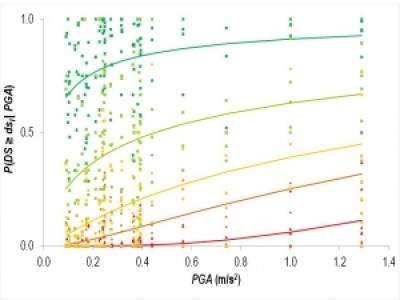Part of the Global Earthquake Model (GEM) this project looks to develop best-practice guidelines and innovation in the development of fragility (probable damage versus earthquake ground motion intensity) and vulnerability (probable loss versus ground motion intensity) functions for buildings under earthquake loading. The project is led by Professor Keith Porter (University of Colorado) and includes researchers and academics from EPICentre, Stanford University (USA), USGS, EERI, Universidad Catolica (Chile) and GeoScience Australia.
EPICentre leads both the empirical vulnerability component (Rossetto and Ioannou), and the Analytical Vulnerability component (D'Ayala and Meslem).

Figure: Fragility curves for field stone masonry buildings based on data obtained from post-earthquake surveys of the 1980 Irpinia earthquake (data from the Cambridge Earthquake Impact data database). Damage scale used is MSK-76. Considerable scatter is observed for the well-populated lower intensity levels and small number of data exist for higher intensity levels.
The empirical component involves the development of fragility and vulnerability relationships from observations of damage or loss (economic or life loss) in past earthquake events. A thorough review of existing empirical studies has been carried out and a compendium of existing empirical relationships compiled. A first draft of the guidelines for the development of new empirical curves has been created and the proposed methods are being tested in collaboration with GeoScience Australia and Universidad Catolica. Innovative methods have been proposed for regression and uncertainty incorporation that are also being actively discussed and checked with Stanford University.
The aim of the analytical vulnerability component is to develop guidelines to provide a consistent and robust method to derive vulnerability and fragility functions analytically, accounting for regional priorities and cultural factors, for a variety of building typologies and characteristics. The project investigates methods of different complexity to obtain fragility functions, from simplified methods based on predetermined behaviour, to push-over analysis and incremental dynamic analysis. Particular attention is paid to the identification and propagation of the uncertainties associated with each methods, from modelling to vulnerability function construction. An important task of the project is also to collect and organise analytically derived fragility functions, available in literature and to propose assessment criteria to rate them in several quality dimensions.
This research builds on significant experience in earthquake fragility and vulnerability estimation in EPICentre as well as earthquake reconnaissance experience.
The draft review of literature, guidance documents and compendium are available on GEM Nexus for both empirical and analytical components.
Sponsors: GEM
Epicentre Staff Involved: Ioanna Ioannou, Tiziana Rossetto, Dina D'Ayala, Abdelghani Meslem
 Close
Close

